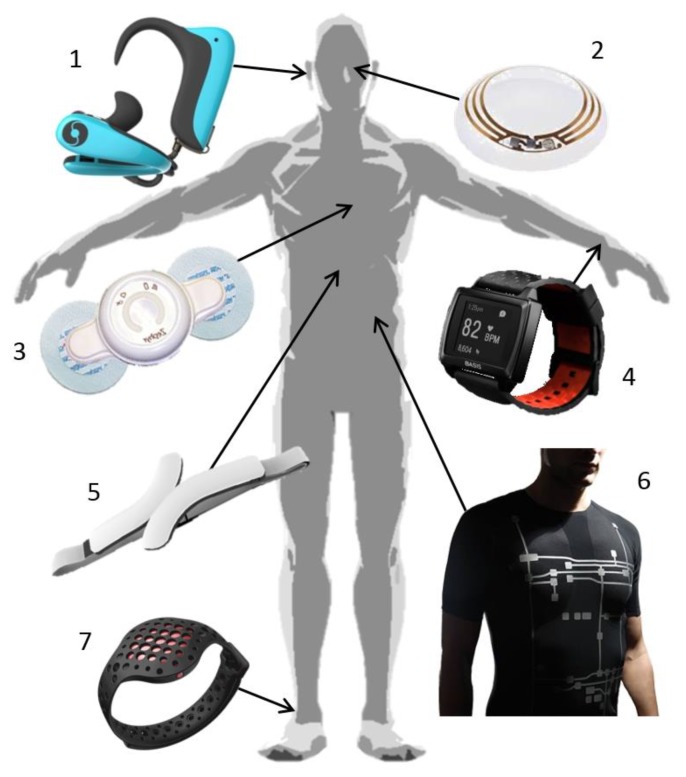Home » Chemistry Degree Programs at Western Oregon University » Student Activities » Chemistry Corner » Advancing the Frontiers of Medicine » Health Wearables
MenuAdvancing the Frontiers of Medicine
Health Wearables
By Eva Sanchez
Health wearables are defined as devices that allows individuals to monitor their vital signs throughout their daily life. This also applies to clinical settings and allows the individual to experience minimum discomfort and interference with their activities. The purpose of wearable health devices is to allow patients to be in control of managing their own health and interactions with health providers (Dias & Paulo Silva Cunha, 2018). Currently, it is typical for the health wearable devices to be purchased by individuals who live a healthy lifestyle already (Piwek, Ellis, Andrews, & Joinson, 2016). The wearable health devices can be used for personal wellness purposes, monitoring one’s body, and used in medical settings. Wearable devices have been created to monitor health aspects because of the aging population and prevalence of chronic diseases (Dias & Paulo Silva Cunha, 2018).
One of the common wearable devices is the wristwatch or smartwatch. These devices have been used to track activity, fitness, and physical levels. Health wearable devices monitor various vital signs: heart rate, blood pressure, respiration rate, blood oxygen saturation, blood glucose, skin perspiration, and body temperature (Dias & Paulo Silva Cunha, 2018). The use of these devices to monitor vital signs poses many advantages. Blood pressure is commonly monitored by the use of a cuff. Although, continuous use of the cuff has negative side effects such as skin irritations and sleep disruption. The use of technology to monitor blood pressure can eliminate those unwanted side effects. The monitoring of blood glucose is of importance for individuals with diabetes. The most common method to check blood glucose levels is collecting a blood sample by poking the finger with a lancet. Devices have been developed to allow individuals to monitor their glucose levels without continually having to poke their finger for a blood sample. One device to monitor glucose levels was the GlucoWatch. The GlucoWatch would monitor blood glucose through the skin providing glucose levels every 20 minutes (Dias & Paulo Silva Cunha, 2018). The GlucoWatch device was later discontinued in 2007 due to the skin burning effects it caused. Since then, other devices such as bioimpedance spectroscopy and electromagnetic sensing have been created. Although, these devices come with some negatives as well, such as having to rest for 60 minutes prior to use with the bioimpedance spectroscopy and the electromagnetic sensing being affected by the temperature (Dias & Paulo Silva Cunha, 2018). Another device to measure blood glucose is the Dexcom. Which has a small needle sensor that goes under the skin and a transmitter sends data to a monitor that charts the blood sugar levels (Cristol 2018).
There are some cons associated with the use of health wearable devices. First, the reliability and validity are examined. These devices are displayed to help improve one’s general health and fitness. Although, many manufactures do not provide evidence to support that their products are effectiveness (Piwek, Ellis, Andrews, & Joinson, 2016). The privacy and security of patients is also a problem. Manufacturers who sell the devices may collect and store the data, therefore, users who purchase various devices do not own their data (Piwek, Ellis, Andrews, & Joinson, 2016). Some companies even charge monthly fees to users in order to access their “raw” data (Piwek, Ellis, Andrews, & Joinson, 2016). Most importantly, some devices are easy to hack which can result in patients’ health data being lost or distorted.
Health wearable devices pose advantages as well. They allow individuals to monitor their health for longer periods of time outside of clinical environments. This also gives them data on their health to discuss with their health care providers at later times. Many health wearable devices are wireless or Bluetooth which allows them to be conveniently worn and used.
Figure 1: Examples of some wearable health devices. (1)—SensoTRACK ear sensor; (2)—Google Contact Lens; (3)—BioPatchTM; (4)—Smartwatch Basis PEAKTM; (5)—QardioCore; (6)—Vital Jacket® t-shirt; (7)—Moov (activity tracker)
References
Dias, Duarte, and João Paulo Silva Cunha. “Wearable Health Devices-Vital Sign Monitoring, Systems and Technologies.” Sensors (Basel, Switzerland) vol. 18,8 2414. 25 Jul. 2018, doi:10.3390/s18082414 https://www.ncbi.nlm.nih.gov/pmc/articles/PMC6111409/#B93-sensors-18-02414 (accessed Apr 29, 2019).
Piwek, Lukasz, et al. “The rise of consumer health wearables: promises and barriers.” PLoS Medicine, vol. 13, no. 2, 2016. General OneFile, http://link.galegroup.com/apps/doc/A456094767/ITOF?u=s8399535&sid=ITOF&xid=00a04249. (Accessed 13 June 2019).
Cristol, H. “What Can Biosensors Tell You About Your Health?” WebMD. May 24th, 2018. https://www.webmd.com/cancer/features/biosensors#1 (accessed May 2, 2019).


